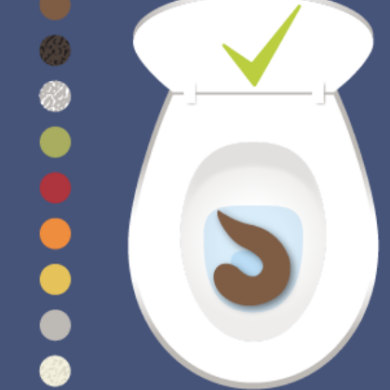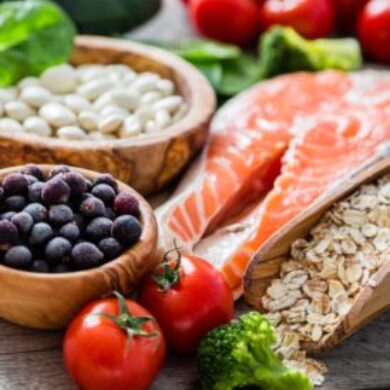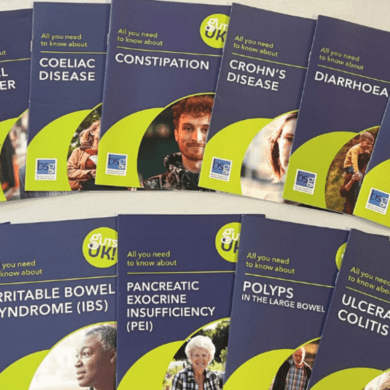Bloating and distension
Download printable versionOverview
This factsheet is about bloating and distension
This factsheet helps to explain what symptoms of bloating and distension are and what causes them. It will help you identify when it is a problem needing your doctor to investigate it. The information also highlights what treatments are available to help reduce symptoms.
Bloating is an uncomfortable feeling of fullness. It can be reported as pressure or tension in the belly (abdomen). Sometimes bloating can be accompanied by a visible widening of the girth or waist. This girth widening symptom is called distension. People can have either or both these symptoms.
Who has bloating and distension?
 Bloating and distension are common symptoms. 4 out of 10 people in the general population may experience occasional bloating. The symptoms are common for people who also have a diagnosis of a disorder of the gut brain interaction (DGBI). This is where there is a disorder in the communications between the brain and gut. The most common of these conditions are irritable bowel syndrome (IBS) and functional dyspepsia. 9 out of every 10 people with IBS experience these symptoms. Symptoms are more common in people with IBS with constipation and chronic, long-term constipation. Half of people with functional dyspepsia experience bloating. Bloating is also a symptom of gastroparesis. Gastroparesis is a condition where the nerves to the stomach don’t work properly. It affects how food to empties from the stomach.
Bloating and distension are common symptoms. 4 out of 10 people in the general population may experience occasional bloating. The symptoms are common for people who also have a diagnosis of a disorder of the gut brain interaction (DGBI). This is where there is a disorder in the communications between the brain and gut. The most common of these conditions are irritable bowel syndrome (IBS) and functional dyspepsia. 9 out of every 10 people with IBS experience these symptoms. Symptoms are more common in people with IBS with constipation and chronic, long-term constipation. Half of people with functional dyspepsia experience bloating. Bloating is also a symptom of gastroparesis. Gastroparesis is a condition where the nerves to the stomach don’t work properly. It affects how food to empties from the stomach.
Half of people with bloating may experience bloating without distension. People who have supragastric belching can also experience bloating and distension. Supragastric belching happens when people belch too often, more than 10 to 20 times a day.
Bloating and distension can also occur without other digestive symptoms. They may be caused by functional bloating and distension. This is a disorder of the brain gut interaction (DGBI). Bloating occurs in more often in females than males. More research is needed to determine who is at risk of developing these symptoms.
Symptoms
What are the usual symptoms?
- An uncomfortable feeling of belly (abdomen) fullness or pressure. This is also reported as having a sensation of trapped gas.
- The waist or girth increases in diameter.
- Belly pain and/or:
A change in bowel habit (diarrhoea and/or constipation) can affect some people with this condition. 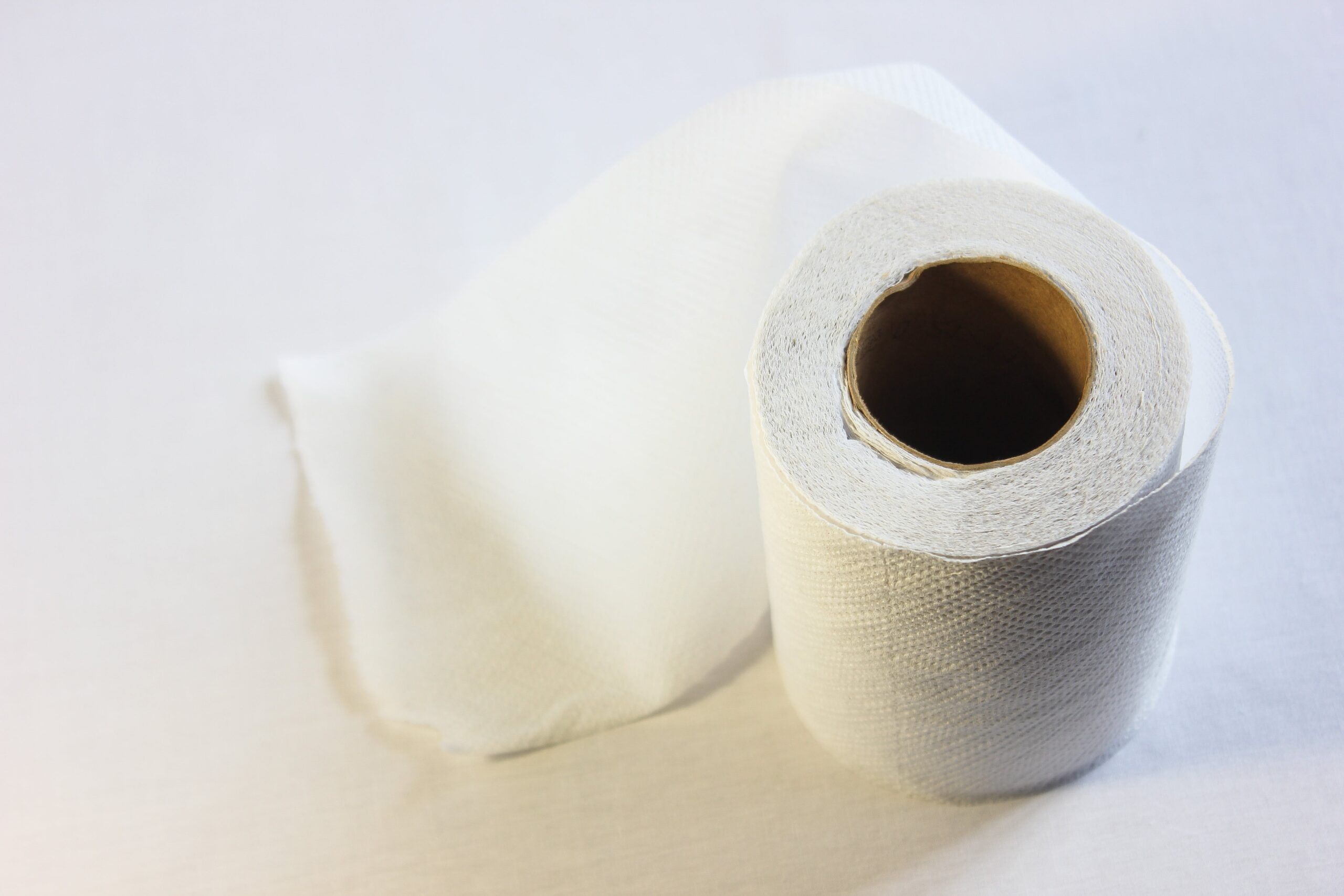
- People can experience bloating with or without distension. They often report that their stomach is flat on rising from bed, and symptoms worsen with eating meals throughout the day.
Red flag symptoms or findings that suggest further investigations might be needed to rule out diseases that cause these symptoms include:
- Unintentional weight loss.
- Anaemia (a low blood count)
- A change in bowel habit (constipation and/or diarrhoea).
- Loss of appetite.
- Belly pain.
- Increased needing to pee.
If you were born female and have ovaries, you should be tested for ovarian cancer if you have bloating. A simple blood test for ovarian cancer can be arranged your GP.
Causes
Why does bloating and distension occur?
The complex mechanisms that lead to bloating and distension are not fully understood.
Bloating can have several causes including:
- Slow movement of contents, including gas, through the digestive tract.
- Impaired evacuation of gas.
- Abnormal digestion of food, caused by bacterial fermentation of food in the gut.
- Abnormal belly (abdominal)/diaphragm reflexes.
 Distension is due to a problem with the muscles in the diaphragm and belly wall muscles. The diaphragm is a large muscle that separates the belly from the chest. In people who don’t have distension the diaphragm normally relaxes. Then the abdominal wall muscles contract (shorten). This helps to accommodate the contents of the gut when they increase. This process is called a reflex, as it happens quickly and is not under the person’s direct control. In people who have distension the opposite occurs. The diaphragm contracts (shortens) and the belly wall muscles relax. This causes the guts contents to be pushed downwards and the belly to bulge outwards.
Distension is due to a problem with the muscles in the diaphragm and belly wall muscles. The diaphragm is a large muscle that separates the belly from the chest. In people who don’t have distension the diaphragm normally relaxes. Then the abdominal wall muscles contract (shorten). This helps to accommodate the contents of the gut when they increase. This process is called a reflex, as it happens quickly and is not under the person’s direct control. In people who have distension the opposite occurs. The diaphragm contracts (shortens) and the belly wall muscles relax. This causes the guts contents to be pushed downwards and the belly to bulge outwards.
Diagnosis
How is bloating and distension diagnosed?
Bloating is a very subjective symptom and is not measured easily. There are no tests that can identify it. Distension can be measured by measuring the change in waist size. These disorders can be identified, by the person reporting symptoms to their doctor.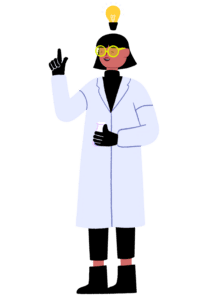
Your doctor may ask for tests to exclude other reasons for the symptoms. The tests might include blood tests and an x-ray of the belly. If someone has diarrhoea and/or constipation symptoms, they may need different tests. See our information sheets on constipation and diarrhoea for further details. To diagnose functional bloating and distension the symptoms must be present for at least 3 months. Functional bloating is diagnosed when there are no other diseases causing the symptoms.
Treatment
How is bloating and distension treated?
The treatment will depend on the cause of the bloating and distension. If you have functional dyspepsia or IBS, you might want to try the treatments for those conditions.
Medicines:
Simethicone
Some medicines with simethicone may help reduce bloating in certain individuals. Simethicone-containing pills work by connecting smaller gas bubbles, to make larger bubbles. These are easier for the person to release. In this way it eases trapped wind. This medicine is also used to help babies with colic. You can check the label inside the wind relief tablet to see if it contains simethicone. Products containing simethicone are unsuitable for people taking Levothyroxine. This is because it can stop Levothyroxine being absorbed. Talk to your pharmacist or doctor to check it is suitable for you.
 Peppermint oil medicine. Taking this medicine before meals for a month can reduce distension and bloating symptoms in some people. Peppermint in medicine capsule form was used. Your doctor can prescribe this for you. For some people, taking peppermint capsules can worsen heartburn and reflux symptoms. Talk to your doctor or pharmacist about whether this medicine would be suitable for you.
Peppermint oil medicine. Taking this medicine before meals for a month can reduce distension and bloating symptoms in some people. Peppermint in medicine capsule form was used. Your doctor can prescribe this for you. For some people, taking peppermint capsules can worsen heartburn and reflux symptoms. Talk to your doctor or pharmacist about whether this medicine would be suitable for you.
Diet.
Simple changes to try to reduce bloating include:
- Limit intake of gas-producing foods e.g. beans and pulses, Brussels sprouts, cauliflower.
- Limit sugar-free mints/chewing gum containing polyols (see FODMAPs description below).
- Eating oats (such as oat-based breakfast cereal or porridge).
- There is some evidence that Linseeds may be effective to reduce bloating. Take up to one tablespoon per day with a cup of fluid. Linseeds may take several weeks to show an effect.
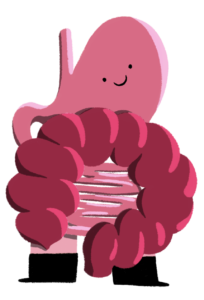 For people who have been diagnosed with IBS, the diet may help reduce bloating symptoms. This is a second line diet therapy for IBS. Food causing wind and bloating can include range of components found in food. These are called FODMAPs. The acronym stands for fermentable oligosaccharides, di-saccharides, monosaccharides and polyols.
For people who have been diagnosed with IBS, the diet may help reduce bloating symptoms. This is a second line diet therapy for IBS. Food causing wind and bloating can include range of components found in food. These are called FODMAPs. The acronym stands for fermentable oligosaccharides, di-saccharides, monosaccharides and polyols.
- Oligosaccharides – there are two types, fructo-oligosaccharides and galacto-oligosaccharides. Fructo-oligosaccharides are found in wheat. Galacto-oligosaccharides are found in pulses – chickpeas, lentils, peas and beans.
- Di-saccharides – lactose, a di-saccharide, is a sugar found in milk.
- Monosaccharides – fructose is a monosaccharide sugar found in some fruits and vegetables. Fructose sugars are also added to foods to sweeten them.
- Polyols – sugar alcohols. These are often found in sugar free sweets, chewing gum and drinks. If a polyol is in a food, it can be identified from the ingredient list. Common names to check for are sorbitol, mannitol or erythritol.
 The Low FODMAP diet is designed to help people identify foods that trigger symptoms. The FODMAP diet works for around a half to two thirds of people with IBS. This would be a second line diet treatment dietitians would consider. It is used when more simple diet advice is not effective. The diet includes three stages. In stage one, FODMAPs are reduced all at once and symptoms should then reduce to a manageable level. Foods are reintroduced to determine which ones are problematic once symptoms improve. This is an important learning stage of the diet. The person then follows a reduced FODMAP diet. A diet including tolerated FODMAP foods is important. This is because FODMAPs are important to gut health.
The Low FODMAP diet is designed to help people identify foods that trigger symptoms. The FODMAP diet works for around a half to two thirds of people with IBS. This would be a second line diet treatment dietitians would consider. It is used when more simple diet advice is not effective. The diet includes three stages. In stage one, FODMAPs are reduced all at once and symptoms should then reduce to a manageable level. Foods are reintroduced to determine which ones are problematic once symptoms improve. This is an important learning stage of the diet. The person then follows a reduced FODMAP diet. A diet including tolerated FODMAP foods is important. This is because FODMAPs are important to gut health.
Most FODMAP foods are prebiotic. Prebiotics are food for gut bacteria and support the growth of beneficial bacteria. The diet is complex, it should be done with the help of a registered trained dietitian. There is no evidence that this diet works for other digestive diseases yet. But the diet can reduce bloating and distension in people with IBS.
Alpha-galactosidase
Alpha-galactosidase is an enzyme that can help digestion of foods containing galacto-oligosaccharides (GOS). GOS is generally found in peas, beans and pulses. Alpha galactosidase is in certain over the counter medicines that lessen gas. There is some evidence that it can help to reduce bloating. Ask your pharmacist about which ones might help you.
Biofeedback training
Pelvic floor biofeedback treatment can cut bloating and distension symptoms in half. This treatment is available from physiotherapists. This treatment may be difficult to access but you can ask your GP for a referral.
Probiotics
Probiotics are foods, drinks or capsules containing live bacteria or yeasts. They can be tried to help to reduce bloating in people who also have IBS. A specific strain or product cannot be advised at this time. Take the dose as the manufacturer recommends and try one product for at least 2 months. If they are effective, you may need to continue to take them.
Support
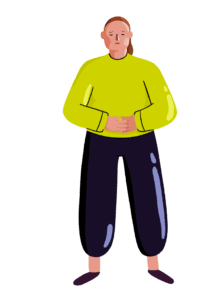 What to ask your doctor?
What to ask your doctor?
- Is my bloating and distension normal?
- Do I need investigations for other conditions?
- What medicines can help me?
- Could you refer me for biofeedback training?
Research
For more information about research in this area please contact Guts UK Charity on:
Telephone: 0207 486 0341
Email: info@gutscharity.org.uk
References available on request.
 What we do
What we do
Guts UK’s vision is of a world where digestive diseases are better understood, better treated and where everyone who lives with one gets the support they need. We fund life-saving research into diseases of the gut, liver and pancreas.
Champion our cause; help us fight digestive diseases and change the lives of millions of people in the UK by supporting our work today.
Discover more:
This information was published by Guts UK in 2023 and will be reviewed in 2026. The information was written by Guts UK and reviewed by experts in bloating and distension and has been subject to both lay and professional review. All content on this page is for information only and is based on the UK health system. The information on this page is not a substitute for professional medical care by a qualified doctor or other healthcare professional. We currently use AI translation tools on our website, which may not always provide perfect translations. Please check for further explanation with your doctor if the information is unclear. ALWAYS check with your doctor if you have concerns about your health, medical condition, or treatment. The publishers are not responsible or liable, directly, or indirectly for any form of damages whatsoever resulting from the use (or misuse) of information contained or implied by this information. Please contact Guts UK if you believe this information is in error.
